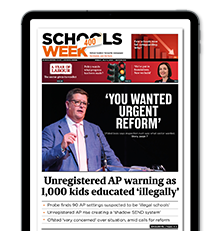More focus is needed on a “second transition” for pupils leaving year 7 and absence sanctions are “insufficient” to meet attendance challenges, a new report has found.
A new study of more than 200,000 pupils has identified some of the key drivers of absence among the attendance crisis.
Ministers this month launched a national marketing campaign to try and get more pupils back to the classroom post-pandemic.
In total, 22.3 per cent of pupils missed more than one in 10 sessions in the 2022-23 academic year. This has barely improved from the 22.5 per cent rate in 2021-22, despite huge focus from schools and politicians.
ImpactEd Evaluation has today published its first report from its Understanding Attendance Project, which analyses data from 200,000 pupils and surveys with 30,000 young people.
Owen Carter, director of ImpactEd Evaluation, said the findings “cast light on the approaches schools might consider as they seek to develop a culture of belonging for all young people.
“They also highlight the importance of schools analysing the drivers in their own setting: while there are some clear themes, there is no one size fits all solution to this complex issue.”
1. ‘Sense of belonging’ a key driver for attendance
Researchers said pupils’ sense of school membership was associated with their attendance rates. It was a “key driver” of attendance across all contexts.
Pupils in the bottom 20 per cent of school attendance scored 2.83 out of 5 in response to the question “I feel like a real part of the school”.
Female pupils have a weaker sense of belonging to the school community than their males peers.

Male pupils scored 3.21 out of 5 for the statement “I feel I can really be myself at this school”. This is compared to 2.90 for female pupils, a difference of nearly eight per cent.
ImpactEd said females pupils’ lower sense of belonging may also be influenced by their lower sense of safety compared to male pupils.
2. More focus needed on year 7 to 8 transition
ImpactEd’s data found there is a “more pronounced difference” in attendance rates and the drivers of this between year 7 and 8 compared to any other year group transition. This is most pronounced for disadvantaged and pupils with SEND.
Reseachers are calling this a “second transition” following the first school transition from primary to secondary.
Attendance rates for year 7 eligible for pupil premium or with SEND were 92 per cent. But in year 8 these figures fall to 88 per cent and 87 per cent, respectively.
For pupil premium pupils with SEND, attendance rates fell to 83 per cent in year 8 compared to 89 per cent in year 7.
Researchers said year 8 scored lower in all social and emotional measures related to attendance and reported being more anxious.
There was also a statistically significant correlation between attendance and sense of school membership for year 8 pupils, but not for year 7.
“This implies that from year 8 onwards, pupils’ sense of community, or lack thereof, plays a more prominent role in their likelihood of coming to school,” the report reads.
3. Attendance drivers are intersectional
School leaders should avoid considering demographic factors in isolation. For example, pupils who are both pupil premium and have SEND have lower attendance rates.
The difference was particularly stark for female pupil premium pupils with SEND from between year 9 to year 11.

The average attendance for this group in year 11 was just 77 per cent, lower than the average national attendance and 4 per cent below male pupils in the same group.
Researchers said attention to friendships are likely to be particularly important drivers. Females scored 7 per cent lower than males in reporting they were good at making friends, and getting on well with other pupils in their class.
4. Sanction awareness not strongly linked to improved attendance
ImpactEd said data shows that communicating clear consequences of non-attendance “is insufficient”.
Persistently absent pupils were almost as likely as pupils with 100 per cent attendance to report there being consequences if they missed lessons.
Researchers said focusing on positive factors around the benefits of education and opportunities at school may potentially be more impactful than messaging around sanctions.
One of the schools in the project, Mounts Bay Academy, an 11-16 school in Cornwall, found that pupils who were worried about the consequences of being late were less likely to come to school.
The school is revisiting late procedures to ensure pupils are rewarded for attendance, and they realise that the value of attendance is more important than the consequences of being late.















Your thoughts